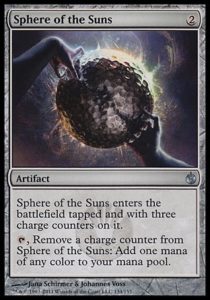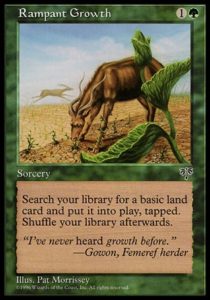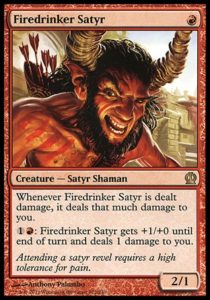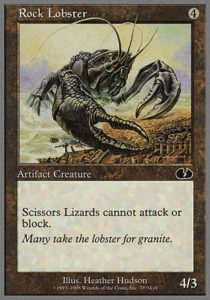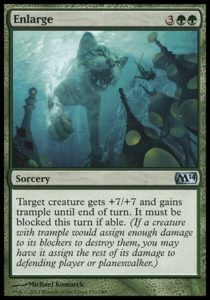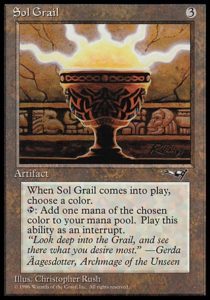Hello, friends, and welcome to (hopefully) a series of articles dedicated to what makes for good Limited design. For our first installment, I’d like to focus on something small (shall we say Limited in scope), but nevertheless important. That topic, as you’ve likely surmised from this article’s title, is fixing, specifically artifact fixing in cubes. The general theory of fixing is applicable to all Limited environments, but today we’ll be focusing on cubes (specifically, an experience with mine), with nods to similar formats, like Modern Masters 2015.
Modern Masters 2015 has three cards at common that I’ve spent a good deal of energy hemming and hawing over in my cube: Wayfarer’s Bauble, Sphere of the Suns, and Alloy Myr (technically, I was debating the merits of the almost identical Scuttlemutt in my cube, but I digress). These are all powerful cards that provide cheap and reliable fixing to decks of all colors. When I added them to my already appreciable amount of colorless fixing (cards like Armillary Sphere, Palladium Myr, Pilgrim’s Eye, and Wanderer’s Twig), they had a dramatic impact on my cube. As I added more colorless ramp/fixing, the worse green and aggressive decks became, while the better control decks became.
Green decks suffered for two reasons: the loss of their identity and their increased competition.
First and foremost, Green lost its unique access to ramp and fixing. Ramp was one of green’s primary archetypes, and green’s ability to enable heavily multicolored decks was previously uncontested. With the prevalence of artifact mana, players didn’t need to play green in order to ramp or fix their mana. Most green ramp spells became (even more) redundant (since there were already a fair number of green ramp spells to begin with), lowering their value.
Secondly, green ramp decks saw increased competition for their finishers. Normally, powerful finishers like Avenger of Zendikar and Ugin, the Spirit Dragon require green mana (or a very durdley control deck) in order to be feasibly cast before the game ends. Those cards would generally go late enough in the draft that the few players in ramp would reliably pick up enough finishers to reward their dedication to cards like Llanowar Elves. However, with the viability of non-green ramp decks, more players employed ramp strategies. Suddenly, green ramp decks had more competition for their finishers. They might get all the green ramp and fixing they’d need, but fail to acquire many, or even any finisher to reward their dutiful archetypal drafting.
Ramp is generally the clearest green archetype in cubes, and its muddling dramatically weakened the color. Sure, green had lots of creatures, but most of them were midrange-y creatures that were generally too slow to win before control came online (or control resolved the finishers they’d taken from green ramp). Green had other themes I could explore, like elf tribal or tokens (which was already a subtheme), but both were more niche and parasitic strategies that failed to employ many of green’s best cards. I’m not saying that there weren’t other avenues for green to explore, but green’s primary strategy was suffering, and I wanted green ramp to be a strong, supported archetype.
Aggressive decks suffered for two reasons: the increased prevalence of their predator, midrange, and the increased speed of their prey, control.
First, with green ramp decks getting weaker, more green decks were playing midrange, aggro’s natural enemy. Creatures like Polukranos, World Eater and Thrun, the Last Troll are very good against cheap aggressive creatures, particularly when cast on turn 3 off of the less desirable, and more plentiful green ramp spells. Aggro’s worst matchup became more prevalent, making aggro decks worse.
Secondly, control was better. Normally, aggro decks have favorable matchups against control decks, since control tends to play slower, expensive cards and may have trouble hitting its land drops or finding its colors. However, cheap, colorless ramp smoothed out these weaknesses, making control faster and more consistent. Suddenly, aggro lost a lot of its edge in its best matchup, making aggro even worse.
As aggro and ramp decks got worse, they became less prevalent archetypes. Midrange and control became became my cube’s most played archetypes, but not for long. There’s supposed to be a basic rock-paper-scissors balance of decks:
Aggro > Control > Midrange > Aggro
However, aggro couldn’t consistently beat control anymore and largely fell out of the metagame. The end result became:
Control > Midrange
It was essentially always a mistake to play midrange decks, since the decks they preyed upon weren’t good or played often. Similarly, green decks were generally a trap, since they no longer were unique and did few things powerful enough to contend with (usually blue-based) control decks. In the end, we had:
Control > ~Control
Control became the de facto best archetype in my cube, and each match was a question of which control player could go bigger, or who ran out of answers first. The imbalance was so severe that there was essentially only one archetype (control) and only four colors to choose from (since green had become so weak). This wasn’t an incredibly difficult situation to fix—I removed most of the artifacts that fixed and ramped, added more good aggro cards, and put in more color-committing finishers so that green fixing would be more necessary for those cards to be cast (and playtested judiciously to get the balance right).
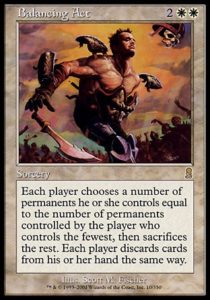
My takeaway was simple: fixing requires a careful balance. There’s certainly a place for artifact mana in cubes, but it requires careful consideration. There’s a reason that the Ravnica signets are only in the MODO powered cube, not the normal Legacy cube. There’s a reason that Mind Stone and Coldsteel Heart are really, really strong. Hell, there’s a reason that the Alpha dual lands are great in cube, and I didn’t even touch upon lands in this article.
I’m not saying that artifacts which both ramp and fix are too powerful for any cube; a little bit of them goes a long way towards making (primarily control) decks better. However, if they’re not used sparingly, they risk upsetting the balance of archetypes and colors. If you do want to use a large amount of them, I have two recommendations for keeping your cube healthy:
First, find ways to keep aggro strong. Make sure that it has fast, efficient creatures like Goblin Guide or powerful cheap creatures like Stoneforge Mystic to allow it to get undernearth and prey upon the accelerated control decks. Let there be plentiful, main-deckable artifact hate, such as Smash to Smithereens, Viridian Shaman, and Leonin Relic-Warder. Cards like Thalia, Guardian of Thraben and Zo-Zu the Punisher can do splash damage against cheap artifacts and acceleration. If you’re really concerned about aggro losing to control, you could even include the scourge of Vintage, Null Rod. That’ll stop the ramping dead.
Secondly, find ways to keep green relevant. You can explore new themes, like tribal Humans/Beasts/Spirits/Elves/tokens. You can make green a more value-intensive color by giving it lots of two-for-one creatures like Indrik Stomphowler and Reclamation Sage. You can double down on ramp with cards like Explosive Vegetation, Primeval Titan, and Eldrazi. Or, you can go full throttle with Vintage cards and play Channel and Eureka. Those are the big guns, but a lot of the artifacts we’re talking about are already howitzers.
Come this Friday and GPVegas, we’ll be opening a lot of Wayfarer’s Bauble, Sphere of the Suns, and Alloy Myr, in addition to the powerful Ravnica bouncelands. These cards will allow a lot of decks to get greedy with their splashes and ambitious with the tops of their curve. Does Modern Masters 2015 have the balance right to allow aggro to beat control without allowing it to run over everything? Hopefully, yes. Only this weekend, and lots and lots of playtesting will tell.
Here’s looking forward to it. And as always, thanks for reading.
—Zachary Barash
Zachary Barash has been playing Magic on and off since 1994. He loves Limited and drafts every available format (including several that aren’t entirely meant to be drafted). He’s a proud Cube owner and improviser, creating entire musicals from scratch every week. Zach has an obsession with Indian food that borders on being unhealthy.

